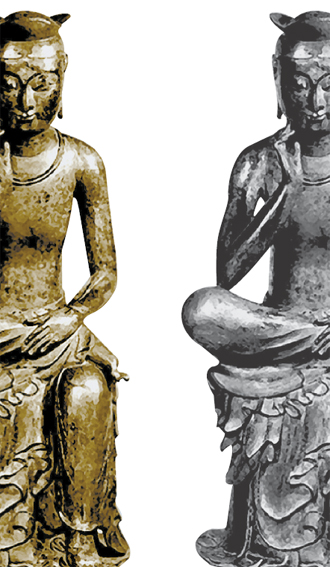Replica plan spurs real controversy

While the former is the country’s representative museum that showcases the most precious and important relics, the latter is a government body tasked with overseeing the management and preservation of the relics.
For the past several months, the two organizations clashed over whether or not to send the Maitreya in Meditation - Korea’s National Treasure No. 83 being kept at the National Museum of Korea - to the United States to be exhibited at the upcoming exhibition titled “Silla: Korea’s Golden Kingdom” at the Metropolitan Museum of Art in New York from Nov. 4 to Feb. 23.
The exhibition, the first large-scale exhibition on the Silla era (57 B.C. - A.D. 935) in the West, will feature some 100 objects from the era and is the result of a collaboration between the Met, the National Museum of Korea and the Gyeongju National Museum, Korea - the two places where the most precious treasures from Silla are kept.
While the museum wanted to show the relic - also called Bodhisattva in Pensive Pose - to the world as it is deemed one of the greatest masterpieces of Korean art, the administration opposed the move, citing concerns about damage as it has already spent too many days abroad.
While that conflict came to an end last month as the Cultural Heritage Administration bowed to joint pressures from the National Museum of Korea, the Metropolitan Museum of Art, the Ministry of Culture, Sports and Tourism and even the Blue House, according to some sources, this time around the conflict regards the creation of replicas for similar dilemmas in the future.
While the administration is saying, “Let’s make replicas so that in the future we can send replicas overseas instead,” the museum is saying the idea is absurd as people won’t come to an exhibition filled with replicas.
With this, some observers are calling the latest conflict between the two organizations “round two.”
Round Two
On Aug. 13, the Cultural Heritage Administration announced in a press release that it will work to create “state-certified replicas” of important cultural properties so that they can be used at exhibitions abroad.
That was four days after the administration reluctantly accepted the National Museum of Korea’s request to allow the travel of the Bodhisattva in Pensive Pose to New York.
The administration also said that using the case regarding the seventh-century gilt-bronze statue as an opportunity, it will seek to improve policies regarding the overseas travel of Korean relics. In addition to the introduction of replicas, the administration said it will also limit the travel of relics that travel too often and that it will also limit the days during which they stay abroad.
“We don’t have specific plans yet, but we will start our preliminary research on foreign cases and the effectiveness of the new measure [on the introduction of replicas],” said Jo Sang-sun, a researcher at the administration’s Tangible Cultural Heritage Division. “We will then set up standards in the production and quality management of replicas and prepare legal procedures to introduce the policy.”
On this, Kim Young-na, director of the National Museum of Korea, reportedly questioned with doubt, “Would it be possible to reproduce the masterpiece which embodies the spirit of an artist?” She said that “making replicas for educational purposes is understandable, but making replicas for exhibitions and presenting them to visitors is deceitful.”
She added that the first task of a museum is to collect, preserve, exhibit and research precious artifacts, and thus it is its responsibility to introduce authentic artifacts to the visitors.
Foreign cases
Those who support the idea of using replicas in overseas exhibitions cite the case of the Mona Lisa, the 16th-century painting by Italian artist Leonardo da Vinci, which has been on permanent display at the Louvre museum in Paris since 1797.
The painting has traveled abroad three times: to the United States in 1962 and to Tokyo and Moscow in 1974. Some observers point out, however, that even during its exhibition in Tokyo and Moscow, the painting was seen at the Louvre, making people wonder which one was authentic.
An official at Tokyo National Museum - where the exhibition took place - says that “more than 1.5 million people came to see the painting at that time, and if the painting was a replica, it would’ve become a diplomatic problem.”
In fact, according to research by the National Museum of Korea, major museums around the world like the Louvre, Orsay museum in Paris and the Metropolitan Museum of Art in New York all have a principle that they exhibit authentic pieces only.
Kang Woo-bang, the director of Ilhyang Research Institute of Korean Art History, argues that “even if Korea uses state funds to make replicas, no one will want to borrow it anyway.” He added that making replicas for exhibitions could be a source of ridicule in the international arena.
However, an official at the Cultural Heritage Administration said that “even if foreign institutions make replicas for exhibitions, officially they say that they don’t.” In other words, it’s something that is done but not publicized.
In Italy, replicas of sculptures are often made and there are cases in which replicas created by professional studios more than 100 years ago are acknowledged as artwork in their own right.
In fact, at its exhibition, “Musei Vaticani” from December to March, the Seoul Arts Center exhibited a replica of the Pieta, the 15th-century masterpiece of Michelangelo Buonarroti currently housed in St. Peter’s Basilica, Vatican City.
BY LEE YEONG-HEE, KIM HYUNG-EUN [hkim@joongang.co.kr]










with the Korea JoongAng Daily
To write comments, please log in to one of the accounts.
Standards Board Policy (0/250자)